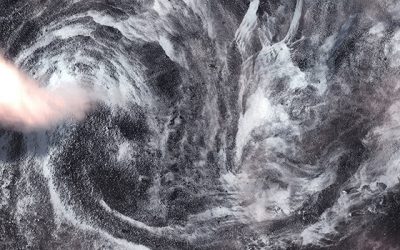Drone Justice: Witnessing the Anthropocene by Dr Adam Fish
There is a lot of propaganda around drones being “disruptive” technologies.


I have been empirically testing the disruptive potentials of drone practices through many diverse contexts throughout the world. Between 2015 to just a few days ago I’ve been conducting participatory and ethnographic fieldwork with drone operators, inventors, entrepreneurs, fanatics, artists, and activists in Indonesia, Sri Lanka, Australia, the US—including Los Angeles and Native America—and the North Atlantic—Iceland, Scotland, Denmark, and the UK trying to see how this flying Turing machine is used in acts of political and economic discovery. I’ve documented 10 potential candidates for drone justice. They cover the issues of surveillance, privacy, information, humanitarianism, ecological, scientific, mammalian, economic, national, and aesthetic. Here is a quick introduction followed by one key question before a brief conclusion.
Beyond the hype, my question is this: Is the drone practice involved in disruptive justice—actual challenges to capitalist incumbencies, extractive hegemonies, and exploitative inequalities—or is it a discursive and ideological “disruption”—effective but first for capital creation.
The answers to this question provide evidence for or against the legitimacy of drone justice.
10 Types of Drone Justice
Surveillance Justice

The Dakota Access Pipeline bringing oil from Canada through the United States including several Native American reservations and sensitive environments, including under the Missouri River, and contributing to climate change. In response emerged an alliance of activists, environmentalists, and Native Americans in the making of the effective up to the point of Trump of stopping this pipeline.
In what ways does the drone used by research participant Myron Dewey at the Dakota Access Pipeline protest at Standing Rock constitute a more than discursive use of drones and a form of counter-surveillance? Will the rights of journalists and activists to use drones to counter-surveil continue or will laws be modified to make illegal such counter-surveillance practices?
Privacy Justice:

Stop LAPD Spying Coalition has a No Drones! Project to stop the violent Los Angeles Police Department from acquiring tax-paid drones for activist and ethnic surveillance.
The question here is can continually racially profiled communities reject surveillance and find drone justice through counter-surveillance and non-discursive understandings of drones’ potentials?
Humanitarian Justice:

Indonesian company Aeroterrscan volunteered its time and technology to monitor the Agung volcano and measure volcanic CO2 emissions.
Does this kind of experiment featuring a collaboration between the USGS, a private drone company in Indonesia, and the Indonesian government represent more than an opportunity to test prototypes for later commercialisation? How would this volcanic CO2 data be used in climate change denialism?
Informational Justice:

Facebook Aquila, and Google Loon, are flying internet delivery platforms for internet delivery around the world. There are also domestic solution such as Helion in Indonesia.
Does Google Loon, Facebook Aquila represent an imperial colonization of national airspace and of electromagnetic spectrum? Does a domestic alternative such as Helion, in Indonesia represent a nationalistic and viable alternative?
Scientific Justice:

Using historical satellite and drone images we have mapped coral bleaching in north Sulawasi, Indonesia.
How does higher resolution images, corroborated with longitudinal satellite imagery and other data signals of coral bleaching, corroborate in public sphere climate change debate and/or denialism?
Aesthetic Justice:
With my friend Sydney Research Fellow Bradley Garrett we tracked with drones the four undersea internet cables connecting Iceland, the Faroe Islands, Shetland Islands, Orkney Islands, Scotland, and into the City of London.
Should the ability to artistically interpret from above be equally distributed? Should counter-surveillance of information infrastructure be democratized? Does seeing equate to affect and result in activism?
Economic Justice:

Former Boeing, Xerox, and Silicon Valley engineer has developed a multi-billion dollar project which he calls the Robotic Air Cargo Network to transform Sri Lanka’s airspace into a series of corridors for drone deliver.
Does this project for high-speed, high-quantity, high-cost good delivery (jewels, luxury goods) in Sri Lanka constitute economic justice or reinforce economic inequalities and extractive industries?
Mammalian Mashup Justice:

The Sri Lanka Wildlife Society is using drones and other air-based platforms—bees, tree houses, airborne citrus scents—to scare away and mitigate the negative consequences of wild elephant and human conflict.
Can there be any other intended result than mere mitigation of collective harm in the ancient entanglement of hydrological infrastructure, elephants, and humans in the Sri Lankan highlands?
National Justice:

Engineers at the University of Moratuwa in Sri Lanka have developed the nations’ first working drone. However, it remains under-appreciated despite being as effective as competitors.
Does the importation of French drones by the Sri Lankan Survey department instead of buying these domestically invented drones constitute economic justice? How will such importation ultimately influence data and air and space sovereignty?
Ecological Justice:

Illegal Palm oil plantation expansions and erosion in West Papua has been mapped by activist friends with their drones.
Do counter-maps, informed by indigenous senses of space and designed through drone deployment, have a legal standing? As most of these drones are gifts from large US NGOs are drones a form of technoliberal developmentalism—which applies feel-good technologies to solve social problems?
Drone Justice and Witnessing
Drones sense from afar and see from a distance. They go where people can go but won’t because of cost to life or capital. Piloting precariously above coral reefs, palm oil plantations, and primary forests is not safe with a helicopter nor cost-effective. So we use drones; risk is transferred from human bodies to technology and capital costs. In these efforts, we are able to witness-from afar, with capital but little bodily risk—earth and human entanglements. In many instances this witnessing is of death, harm, and destruction of ecologies, species, human communities, and biomes. The notion of witnessing bears a significant resonance in the mediation of death, dying, and danger. Media scholar Leshu Torchu mobilizes “witnessing” to describe the atrocious work of genocide documentary. For media scholar Emily West, witnessing frames the relationship between audiences and those willfully dying on television. Journalism scholar Brian Creech (2017) critiques the labor of war reporters whose mortality is at risk in exchange for the audience affective of bearing witness to the gruesome details of war-making. In each of these cases, witnessing an end of life is a beginning of a dialogue about a future. These scholars are sceptical of the mobilisation of witnessing for pity. They emphasize how witnessing generates an affect of activism for the building of a systemic future. It is less about mourning the dead or saving the dying than providing for the yet-to-live, the future generations self-awareness of multi-cultural and multi-species entanglements.
Justice drones bear witness in this manner, not only to earthly destruction and inequities, but through their practice to the future of resistance. This is drone disruptive justice, an action which rejects oppression while bearing witness to the rich complex forces of oppression. From above, drones put destruction into perspective, inclusive of oppositional humans, extractive as well as liberatory technologies, and monocultures as well as species within biodiversity. Drones for justice bear witness to the sociotechnical life and multispecies dead, dying, living, and being born in the Anthropocene.
According to Stengers, the Anthropocene is an era of ‘multiple entanglements’, between natural or ‘non-human’ forces and human (in)action, or, as Connolly describes this, of ‘entangled humanism’. I prefer a counter or anti-humanism, the non-human witnessing of death, destruction, and crisis of entangled people, networked systems, and non-human species. What does entangled anti-humanistic, biological witnessing mean in the anthropocene? Withering coral, farmed palms, biologists, activists, carbon dioxide belching volcanoes, and trash eating elephants as seen through automated and roaming drones—and carbonised air, hot and acidified oceans, and poor humans seeking environmental justice with drones—this is the multi-species entanglement of post-human drone justice and its becoming. Here a drone is both an agent within this compromised atmosphere, an optic on to terrestrial colonisation and oceanic biodiversity deletion— as well as a tool for witnessing, mapping, sensing, and hacking Anthropocentric transformations of the global biome.



